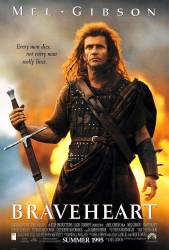Trivia: Perhaps you're wondering what William Wallace shouts after delivering his speech just prior to the Battle of Stirling. It's "Alba gu brath," which means "Scotland forever."
Trivia: The Irish Army personnel, who were used as extras in the battle scenes, had an unfortunate habit of wearing wristwatches and sunglasses, causing several scenes to be re-shot.
Trivia: Wallace - Sir William Wallace - was a noble, not a scruffy tribesman as shown in this film. As such, his trial (such as it was) and execution were detailed in the court records of the day and they still exist. He was dragged the three and a half miles from the Tower to Aldgate naked, and he was chained (not tied) to a piece of fencing, not on a wheeled cart. He was never 'racked', just hanged vertically. He was never offered a chance to recant his beliefs in exchange for a quicker, more merciful death. While hanging, still alive, he was emasculated ('his privy parts cut away') and his genitals burnt on a brazier in front of him. The executioner then slit open his abdomen and disemboweled him, then his chest was cut open and his heart torn out. He was never allowed to speak, was not tied to a flat table and was beheaded after he was dead. The film gets all of this wrong.
Trivia: Mel Gibson did such a good job on shooting and editing the battle scenes that many were convinced that the fake horses he used were real, including the RSPCA who investigated the movie.
Trivia: The titular moniker of "Braveheart" in actuality referred to Robert the Bruce, not William Wallace.
Trivia: For much of ‘Braveheart' Robert the Bruce is torn between the choice of following his conscience by helping William Wallace or submitting to the English as a puppet ruler of Scotland. Thus he serves with the English army at the Battle of Falkirk, but helps Wallace to safety after the Scots are defeated. At the end of the film he is about to finally submit, when he has a change of heart, calls his followers to fight, and defeats the English. This is nonsense. Robert the Bruce was among the first Scottish noblemen to resist English control of Scotland. Edward I's Scottish wars lasted for more than ten years, and, at times, when it seemed that Edward had crushed all opposition, Robert the Bruce (like most Scots) made a half-hearted submission, but he soon took up arms again. There is no record that he was at the Battle of Falkirk (on either side). In 1306, seven months after Wallace's execution, he had himself crowned King of Scotland, provocatively rejecting English authority. For the rest of his life he waged uncompromising war against the English, culminating in his great victory at Bannockburn.
Trivia: The sound effects used for the arrows in the Stirling war were used in the opening cinematic of the Tomb Raider 2 video game.
Trivia: Mel Gibson initially turned down the role of William Wallace because he felt he was too old for the part.
Trivia: Even though they play father and son in this film, James Cosmo and Brendan Gleeson are only seven years apart in age.






Answer: It's called "A Gift of a Thistle" and it's on the soundtrack conducted by James Horner. Incidentally, the tune is a recurring theme throughout the film's music, and appears in several other songs on the soundtrack as well. Also in relation to the song, the flower was a thistle.
Krista